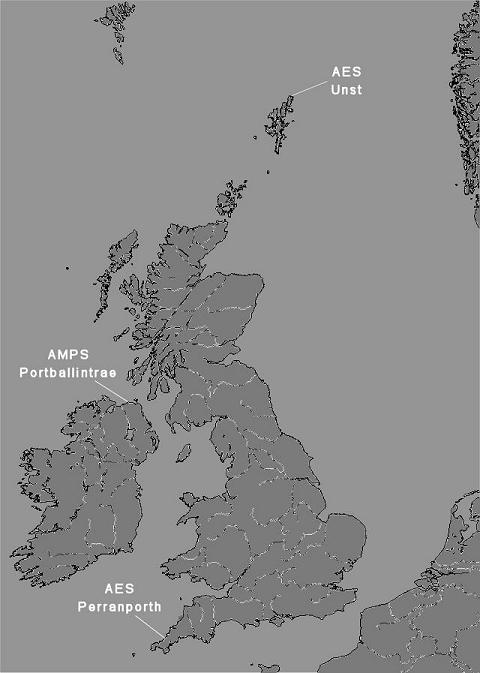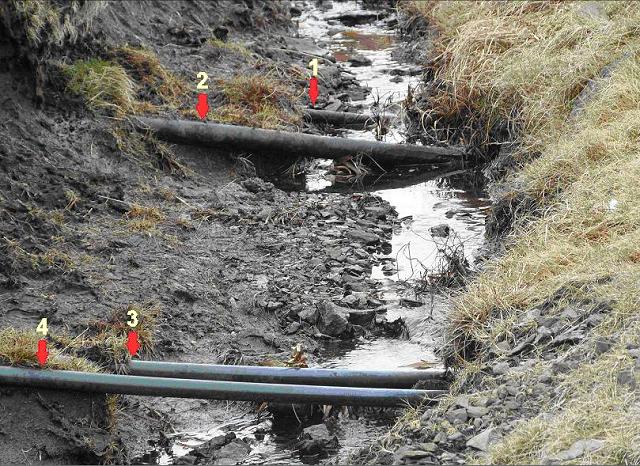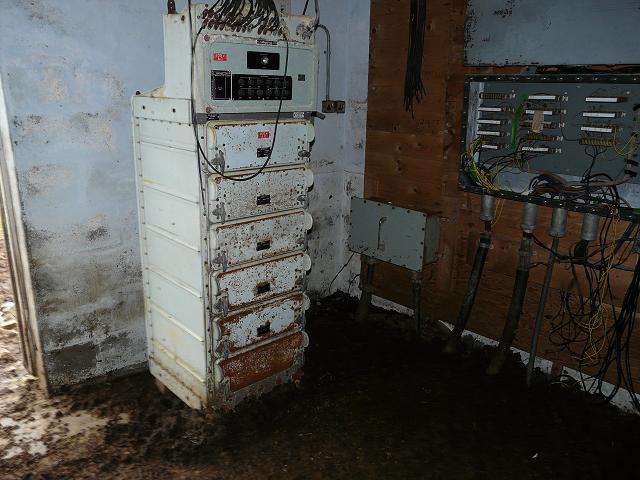 Admiralty Research Laboratory - Passive Sonar research
Admiralty Research Laboratory - Passive Sonar research
 Admiralty Research Laboratory - Passive Sonar research
Admiralty Research Laboratory - Passive Sonar research
Inter-linking Admiralty Research Laboratory Programmes: CORSAIR, KNOUT, DICE & SOAP
Introduction
The most common topic researched by the Scientific and Experimental staff of the Admiralty Research Laboratory (ARL), from its early days, was the propagation of sound in water - how sound is conducted and distributed by water. These studies led to the development of equipment with the capability to detect ships and submarines, at ranges to 10 nautical miles by reflected sound waves, and to (eventually) greater ranges by reception of the sound radiated by the distant vessel; the former radar-like technique is known as Active Sonar, and the latter listening technique is Passive Sonar. {The 1950s term for both active and passive sonar was ASDIC.}
An ARL programme of work was established under the codename of CORSAIR as an initiative to achieve even greater ranges, perceived as necessary to counter the threat posed by the growing number of Soviet-operated submarines. The CORSAIR programme included study, experiments and development of shore-based, submarine detection methods using low frequency sound, with the initial emphasis on wide-band correlation techniques. Equivalent submarine-borne equipment was developed by staff at the Admiralty Research Laboratory under the codename KNOUT. Further, under the codename DICE, ARL staff were investigating the potential of digital signal processing for sonar applications by constructing the Digital Acoustics Computer - very probably the World's first; it shared (fundamental) digital elements design with Bletchley Park's Colossus and, further, it was also conceived to derived a statistically-based result from permutations of the input data.
The CORSAIR research programme evolved into a very large project that necessitated the formation of a specific group known as the CORSAIR aka J-Group, an off-shoot of the ARL's Acoustics Group aka D-Group. Upon completion of the CORSAIR programme, further rationalisation of the ARL work on acoustics took place, circa 1960, with the formation of ARL's Submarine Detection Group (L-Group). J-Group was disbanded and the CORSAIR and KNOUT research absorbed into aspects of L-Group's work on long-range Passive Sonar equipment for submarines, programmes DICE II and SOAP.
The Admiralty Research Laboratory's research programme CORSAIR involved three ARL outstations as follows:-
Admiralty Experimental Station Perranporth, North Cornwall was used for the initial investigations and development of the Passive Sonar technique, over the period 1952 to 1957;
Admiralty Marine Physical Station (AMPS), Portballintrae, Northern Ireland was set-up specifically as a level of protection to shipping in the Clyde Approaches, in 1953;
Admiralty Experimental Station Unst, Shetland Isles was established in 1955 on the northernmost Shetland isle to evaluate techniques for land-based detection of Soviet submarines in transit, such that they may be tracked, trailed and neutralised.

Map showing the three ARL outstations involved in
the CORSAIR programme
Long Range Submarine Detection
By 1952 there appeared to be two promising techniques for detecting submarines at long ranges (up to 100 miles) by novel processing of the signals from a long array of hydrophones sited on the seabed. As well as employing novel processing techniques, the postulated systems were equally novel in that they would exploit the (fairly recently observed) low audio frequencies emanating from submarines i.e. they were listening, commonly known as passive, sonars.
Candidate Detection Techniques
The US system employed a narrowband technique using frequency analysers capitalising on the discrete frequencies radiated, whereas the UK system grew from an idea of applying a technique developed by Sir Martin Ryle (a radio astronomer at Cambridge University) for detecting weak radio emissions by correlation of the signals from widely separated antennae, over a wide frequency band.
Projects
The US concept development went under the project name of JEZEBEL, which evolved into an airborne sonobuoy system and also the SOSUS – the extensive underwater surveillance system. The UK initiative became known as
CORSAIR, and actually reached the stage of having a RN operational sonar (number) allocation of type 191.
In all events things moved very rapidly. The impression is that senior naval staff viewed a seabed-sited long range detection and location system to be a force-multiplier, relieving naval and air units from patrols, and so allowing them to concentrate on the prosecution of targets; thereby compensating for the lack of (suitable/capable) deployable units.
The US JEZEBEL system developed quickly with the Bell Telephone Laboratories, Murray Hill, New Jersey, under contract to the USN via ONR, to produce the acoustic signal processing portion based on their research of frequency analysers for telephonic work.
The Admiralty Research Laboratory (ARL) assessed the UK CORSAIR technique in 1952 at the (ARL run) Admiralty Experimental Station (AES) at Perranporth on the north Cornish coast. The assessment was highly successful and demonstrated a spectacular improvement over previous methods of passive listening. The passive detection of submarines by cross-correlation of a pair of widely spaced hydrophones, to ranges of the order of 100 miles was indicated. This was a factor of ten improvement over existing sonars, with the enormous tactical advantage that the target had no clue that it was detected.
UK Initiatives
In some haste, two inter-linked UK initiatives were launched circa 1953. The first was the establishment of a
CORSAIR listening shore-base on the coast of Northern Ireland at Portballintrae, in a strategically important area, with the hydrophone array looking north across shipping lanes.
From the outset, the intention of the underwater system was to provide a
nominal course and speed of detected submarines such that other units
could be directed to intercept the target. Unfortunately the
sound propagation conditions were so poor that only ranges of a few
miles were obtained. Therefore, it was impossible to carry out
adequately the sort of operational investigations for which the station
was envisaged. The title of Admiralty Marine Physical Station signifies
the specific purpose of the short-lived Portballintrae installation to
intercept Soviet-operated submarines, which was shutdown for
experimental work and the site cleared by May 1955.
The second initiative involved staff at Her Majesty’s Underwater Development Establishment at Portland (HMUDE - the equipment development arm of naval R & D) where it was assigned the sonar outfit type number 191. The project included the design and construction of hydrophone arrays to be sited on the seabed.
UK Technique Development
ARL propagation studies continued at AES Perranporth with special purpose arrays being installed in the summer of 1954 for trials to assess different methods of siting the hydrophones, in the wake of the disappointing performance from the installation in Northern Ireland. During the trials a detection range of 70 miles was achieved against a snorting submarine, and the first test of
CORSAIR detection was made against a UK silenced submarine, HMS/M SCOTSMAN. By this time, two major reductions in radiated noise from engines and propellers had been made and assessed by ARL, and
were being carried forward into the design of the PORPOISE class of
diesel-electric submarines.
Experimental Establishment on Unst
When it became clear that detection ranges of the order of a hundred miles or more were conceivable in deep water, interest turned to siting arrays off the northern tip of the Shetlands, looking north into deeper water.
ARL's over-arching task to determine the system design parameters for
the operational system continued. Several propagation trials were carried out (1954-5) in order to assess
the likely system performance in this area, and to choose the most suitable site for the
hydrophone arrays.
Initial Equipment on Unst
Finally in the summer of 1955 the ARL experimental array 1200 feet long consisting of hydrophones spliced into a cable was laid 40 miles out to sea and connected back to a new shore station, AES Unst. A further
ARL array (hydrophone pair) was laid 7 miles to the West of the main array. These arrays posed many problems both in design and laying. The US were invited to participate in the forthcoming trials by providing
prototype JEZEBEL array and narrowband processing equipment, for comparison purposes. Their array
of eight hydrophones was temporarily laid in shallow water on account of defects. In July 1956 the US array was re-laid in its intended position in 350 fathoms but slowly became virtually
unusable (5 of the 8 hydrophones were unserviceable), and in August the main UK array was raised and repaired, as the watertight integrity of the junction box containing control logic had failed.
Most of the shore-based equipment (array signal processing and display) had been installed in the main laboratory of AES Unst by May 1956; such was the haste that the decoration of the (new) laboratory was still incomplete the following year. In July 1956 staff from the Bell Telephone Laboratories in America (under contract to USN-ONR for Project JEZEBEL) installed recording equipment and a LOFAR analyser.
Tightening of Timescales
Due to problems with the arrays and repeated delays onshore the main ARL trials were concentrated into the period from September 1956 to February 1957. The senior naval staff’s demand to telescope the R & D for a
CORSAIR system made it necessary to direct research work so that all information that might be of value in the design and siting of the development equipment (Sonar type 191) might be passed to CUDE (Captain in charge of HMUDE, Portland).
Ships Involved
The list of ships assisting in the ARL work at AES Unst from May 1956 to May 1957 is a long one. HMS FETLAR and HMS TIREE continued to help in everyway in a number of trials to test and check the arrays. Use was made of RRS Discovery II whose experience in ARL work was most valuable. The cable ship ACS St Margarets carried out three intricate relaying operations with eminent success. The ships acting as targets during the main trials were HMS CUMBERLAND, HMS OCEAN and HMS/Ms ARTFUL, SCOTSMAN, TOKEN and TRUMP. Aircraft from Coastal Command, RAF Kinloss provided surveys of shipping in the area during the trials.
Trials at AES Unst
Many trials were carried out using this installation (in the above period), the most important being:-
A series of exercises (called THERMOSTAT I to III) to determine the detection performance of the system against a conventional snorting submarine;
An investigation of the effect of spacing between receivers on “correlation loss”;
A semi-operational exercise called NIGHTSHADE in which an aircraft was vectored along the bearing of any targets detected.
The dates for the ARL led trials were: Thermostat I: 25 Sept to 3 Oct 1956; Thermostat II: 30 Oct 7 Nov 1956; Thermostat III: 6 – 14 Feb 1957; NIGHTSHADE:
early March 1957.
The trials were carried through with success, due to the co-operation of many authorities, and with considerable strain on ARL’s staff and resources. The Superintendent of ARL reported in May 1957
that much of value had been learned; but it is clear that to work in such a hurry is expensive, inefficient and
unsatisfactory.
Early Disappointments
It became apparent from these trials that the high hopes for such a system in this area were not to be realised for two reasons:-
Detection ranges were only the order of 50 miles instead of some hundreds of miles as had been hoped. This dramatically reduced the expected area of coverage and consequently the time taken by a submarine to transit through it. Thereby reducing the likelihood of the submarine snorting during its transit and being detected and subsequently prosecuted.
The amount of interference from fishing vessels was far greater than considered likely.
Operational Sonar Type 191
Nevertheless preparations were already well underway for the prototype operational (Sonar 191) array to be laid by HMUDE. As a result of the propagation and correlation loss measurement both by HMUDE and ARL, the 191 array was positioned some 22 miles further north (70 miles from shore). Signals from all 12 hydrophones were brought back individually to the shore, so that the array could be electronically steered to form 40 beams covering a 180 deg arc,
centered on a north-south line. The ensuing CUDE led trial (THERMOSTAT IV) of the system was undertaken
from 27th November to 6th December 1957 and showed that a range of 70 miles could be expected against a conventional snorting submarine to the north of the array, and about 43 miles inshore of the array. Interference from fishing vessels was (once again) extremely heavy, which greatly exacerbated the interpretation of the trials records.
During the THERMOSTAT IV, ARL staff made tape recordings and the output from their DICE 1 detection processor was of assistance to HMUDE staff.
Following the trial, the Sonar 191 installation at Unst was re-designated Sonar 191X (experimental and unique) and handed-over to ARL. Further, HMS TIREE, which ARL had used since 1953 was loaned to HMUDE, although it was expected that it would soon be reduced to reserve, the same fate as HMS FETLAR that also had assisted in many ARL trials.
Final Conclusion
In the wake of the Sonar 191 trial undertaken by HMUDE staff, it was concluded that this
(CORSAIR) concept of fixed shore-based passive listening systems would be ineffectual against the evolving quieter submarines as typified by the UK PORPOISE class; mainly due to resilient mounting of the engines, together with improved propeller design. These submarines while snorting radiated about 3% of the noise power radiated by earlier submarines. Consequently the whole of the advantage offered by passive long array techniques using broadband or narrowband processing
was nullified, and detection ranges were once again back to a few tens of miles, at best.
Programme CORSAIR's Legacy
The equipment at AES Unst was put on a “care and maintenance” basis
(see note 1, below) as the principal HMUDE staff involved were reassigned to (more pressing) active sonar work for the UK’s nuclear-powered submarines, at the behest of senior naval staff. Likewise most of the ARL staff moved onto active sonar studies under projects
LIONESS and VERONICA. Fortuitously ARL’s parallel work that commenced in 1954 (under the codename KNOUT- a
topside array experimentally fitted to HMS/Ms TIRELESS and THULE) on submarine-borne, long range passive sonar was continued. The first materialisation of this type of system was engineered by HMUDE as Sonar type 186. By 1957 ways were being considered for the inclusion, in a submarine, of one of the signal processing techniques used at AES Unst (produced under codename DICE) for the Sonar 186 array. The cross-correlating equipment known as DICE 1 was used successfully at AES Unst in
the key exercise NIGHTSHADE – the operational assessment of prosecuting land-based
CORSAIR detections using aircraft.
The legacy of the work that culminated in the systems and styles of
signal processing evaluated at AES Unst was principally twofold.
Processing for the type 186 array was developed under the ARL programme codenamed SOAP, the follow-on to programme DICE. This together with ARL’s further self-noise reduction of the P-boats fed into the O-boats (and retrofitted in the Ps) proved highly successful and led to Sonar outfit type 2007 produced by HMUDE for the submarine fleet.
ARL work continued to investigate off-board long arrays leading to fleet-wide passive towed array systems. Early towed array trials utilised the prototype Sonar 2007 processing produced under ARL's codename SOAP and fitted to HMS/M SEALION.
Postscript
Whilst the end of the CORSAIR programme had been reached, this
was by no means the end of AES Unst, unlike AMPS at Portballintrae. For reasons yet to be established,
there was renewed interest over the period 1960-63 with USN involvement, followed by another
quiet spell until 1968. Finally, all interest in ARLE Unst (its name
from 1969 - standing for Admiralty Research Laboratory Extension Unst)
ceased in the 1970s.
Today hints of the installations are to be found, curiously enigmatic!


Sea cables terminal building at Buddabrake, Burrafirth
photo: Gordon Carle
NOTE 1: It was hoped to make routine tape recordings of background noise for analysis at ARL and at Bell Telephone Laboratories.
The above information has been gleaned from a number of sources; the primary sources (to date) being:-
Admiralty Research Laboratory Annual Reports published May 1954/55/57/58 - Annual Reports
ARL Report, "Some Thoughts on the Recent History, Present Status, and Future Prospects of Passive Acoustic Submarine Detection" by Eric Risness, ARL/R43/L, 1961.
The Royal Navy 1930 - 2000 Innovation and Defence, Chapter 10 - Electronics and the Royal Navy 1945 and After by Norman Friedman.
Cold War, Hot Science. Applied Research in Britain's Defence Laboratories, Chapter 7- Aircraft Carriers and Submarines: Naval R & D in Britain in the Mid-Cold War by Tom Wright.
Supporting information sources:-
Seek & Strike. Sonar, anti-submarine warfare and the Royal Navy 1914-54 by Willem Hackmann.
We Come UNSEEN. The Untold Story of Britain's Cold War Submariners by Jim Ring.
Personal recollections of over 30 yrs of Naval R & D (inc. 10 yrs at ARL Teddington & 12 yrs at DRA/DERA/QinetiQ Portland) covering: System & Sub-system Design, Engineering, Evaluation, Analysis & Assessment. Whilst at ARL, worked on DICE and SOAP, and the rejuvenation of AES/ARLE Unst in 1969.
More information on AMPS Portballintrae - view
More information on the Admiralty Research Laboratory's
Passive Sonar research programmes:
KNOUT, DICE & SOAP leading to submarine-borne
Sonar Types 186 & 2007: click here
This page is under construction
| ~ Main Page ~ | ~ Previous Page ~ | ~ Top of this Page ~ |